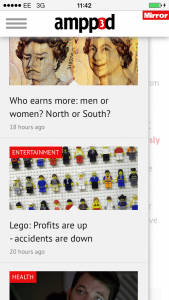How we built Ampp3d in eight weeks
This evening I spoke at #ProductTank – a showcase event about product development hosted by the BBC, explaining how Trinity Mirror built Ampp3d in eight weeks. Here’s what I said…
Ampp3d is the Mirror’s new data journalism site, which we launched just before Christmas. The aim of the project is to make socially shareable data journalism. We’ve used some of the lessons from our viral distractions site UsVsTh3m, and tried to apply them to serious journalism.
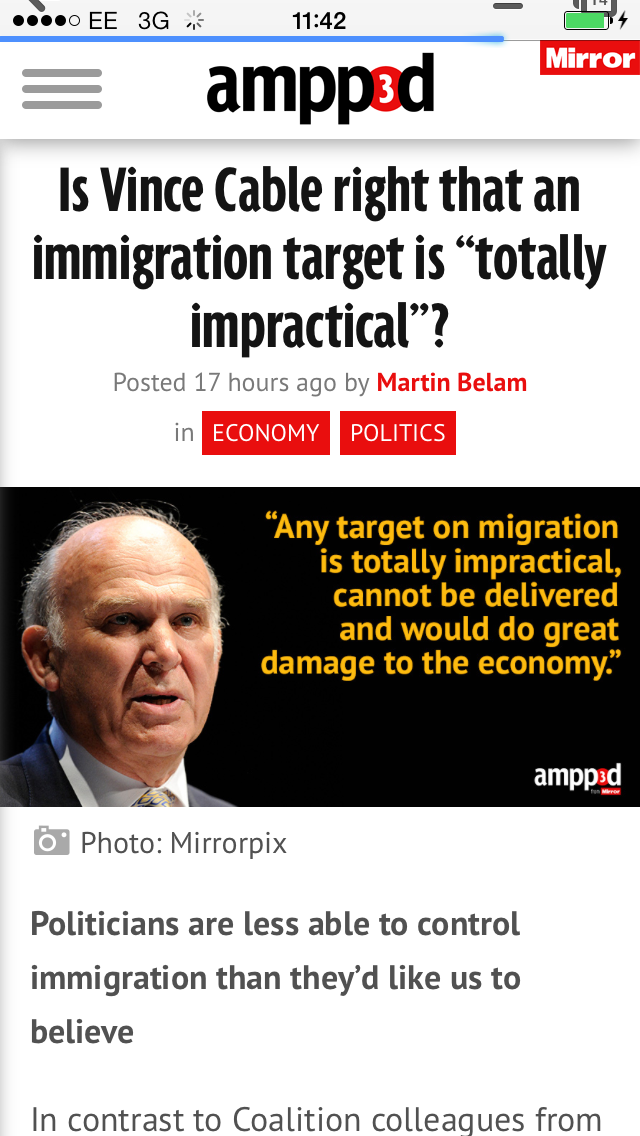
Why did we build it?
First off we’re interested in reaching new audiences. People who may not visit existing Trinity Mirror brands online, or who might not consider the Mirror a news destination they frequent. We’re interested in expanding the demographic range of our existing audiences.
We’re also interested in new ways of storytelling. I think for much of the history of the web most news publishers have simply taken print articles and chucked them into a CMS. Or made TV packages and flung them onto the interwebs. I’m interested in how we can use more interactivity and some of the web’s native features to enhance stories.

Finally, we think there is a gap in the market for this. “Data journalism” has tended to be the preserve of the broadsheet. Very thorough, very worthy, but also often very dry. We want to explore what data journalism from a popular tabloid newspaper looks like online – how to take stats and number-driven stories and make them fun and engaging. Like zipping around on rush hour trains counting people to try and prove Nigel Farage wrong.
I'm at Charing Cross to test @Nigel_Farage's claim you can get on a train where nobody audibly speaks English pic.twitter.com/gOPSZAZAXQ
— Martin Belam (@MartinBelam) March 3, 2014
How did we build it?
I think the key thing has having a small team. Throughout my career the most successful products I’ve been involved with have always been a small team with a laser focus on delivery of one achievable goal. Monolithic projects involve so much project management overhead, that a lot of effort and energy is expended on organising “building the thing”, not “building the thing” itself.
The core team for the delivery of Ampp3d was just three people. I wrote a product spec which was one side of A4 and which the business signed off. I wrote a content strategy document, which was about a side-and-a-half of A4, scribbled a couple of IA sketches, and briefed the designer “I’d like something that works a bit like Quartz but looks like the Mirror mobile site”.
Chris Lam then did a fantastic job of turning that loose brief into the design you see today, with a main focus on the mobile layout. In truth we’ve designed for mobile and tablet, and for desktop just basically stretched the tablet version to a width where it doesn’t look too skinny.
The designs and documents got passed to our sole developer, William Turrell, and he built it on top of WordPress. Really bloody fast. I think about three weeks into the project I had a meeting with my boss, where he was expecting me to say I was pushing the launch date back, and instead I was able to show him a working site with test content.
Aside from the core group of three, another three people enabled it to launch on time. General manager of Mirror Online, Malcolm Coles, has been exceptional at getting permission from the business for me to go ahead with a project, and then clearing all the obstacles so I can just be left alone to deliver.
I spent one day with Knight-Mozilla OpenNews Fellow Annabel Church, talking through the plans and our proposed tech choices. She did a brilliant job of narrowing her eyes at me every time I was making something too complex, or over-looking some Open Source tool that would do the job we wanted.
Finally Heather Bowen was part of the launch team, and helped me greatly with all the nitty-gritty of setting up social media accounts and their strategies, filling in forms for IT requests and security passes, and generally enabling me to get on with the launch. I’m very grateful to her.
Of course there were discussions with other people around Trinity Mirror, but that core team of six was what made us launch on time.
As for product development methodology, I’m a big fan of Agile, and we were as Agile as we needed to be. I gave Will a prioritised feature list, and an idea of my Minimum Viable Product. To be honest, the latter was pretty much “the ability to publish an article with a stable URL, pictures essential, embedded charts a bonus”. He put all that into Trello, and I then, frankly, never looked at it.
Any time there was a query, or a couple of tech options with pros and cons, wherever possible I tried to let Will make the final decision. He’s the expert, he’s the one maintaining the code, and he’s the one who understands the performance implications, so why wouldn’t you allow him to make the decision?
UPDATE: Will Turrell has now written up the technical side of the build, and his blog post is a must-read if you are involved in any kind of web-development.
What have we learned?
1. Mobile is everything. We are well past the tipping point for mobile usage. Sometimes at peak commuting times in the UK something like 80%+ of the traffic is coming from mobile devices. The peak usage of UsVsTh3m’s North-o-meter game was 11pm on a Friday night, 20,000 simultaneous users, 80% on their phones, 60% viewing it within the chrome of a Facebook app. If your site or content doesn’t work in that context, you are throwing over half of your audience away.
2. Mobile is hard. Oh god mobile is hard. Especially when trying to tell complex stories with data. Trying to optimise every graph and chart and graphic so that it works on tiny screens is very restrictive. It drives me nuts. It’s part of the reason we are running a competition for young journalists to produce a mobile data visualisation or infographic, to get some new fresh eyes on the problem. I think it is a symptom of a growing disconnect between the method of digital production and the method of digital consumption. Most publishers give their staff massive desktop monitors to work on, using desktop software tools, and a CMS that works on a desktop. And then the majority of users view the output on a mobile. That’s got to be wrong.
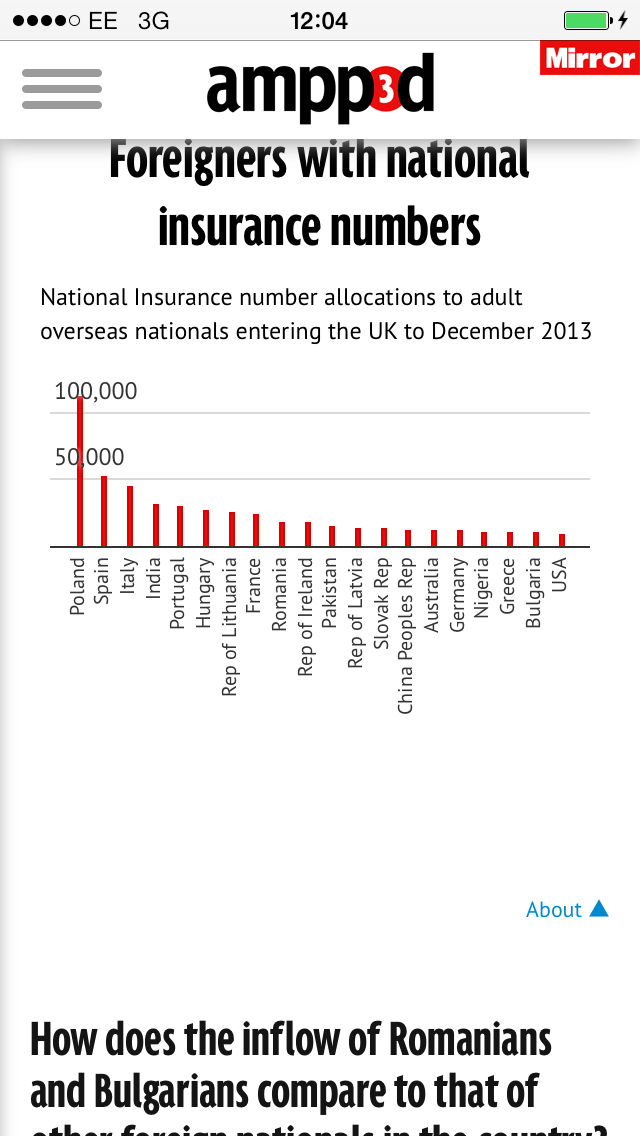
3. Twitter is the canary, Facebook sends the traffic. I naturally gravitate towards lots of activity on Twitter – there are loads of other journalists on there, it’s got a rapid flow of content, and we’ve carved out a real personality on there for @Ampp3d, fixing broken charts and picking fights with Guido Fawkes.
Hey @Conservatives, we fixed the scale of your bar chart for you. pic.twitter.com/7eYOh66aDJ
— Ampp3d (@ampp3d) December 4, 2013
But Facebook is where the traffic is. Getting a bit of quality content and presenting it right so that it is widely shared on Facebook is where we’ve had the successes that have moved our audience size along.
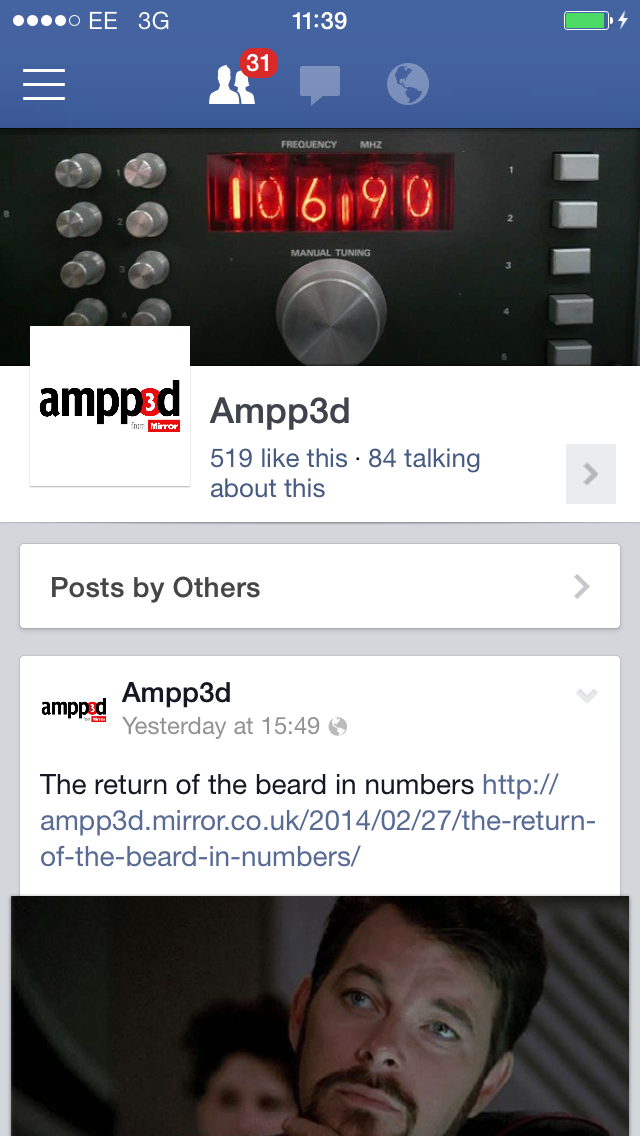
4. I hate my well-meaning friends. OK, hate is a bit of a strong word. But it became a running joke on the Ampp3d desk that pretty much any public criticism of the site in the first four weeks came from someone I knew. Partly because I’ve collected a big social media following of nerdy news and designer people who aren’t shy with their opinions, and partly because people were trying to be helpful.
But certainly nearly every article in the first couple of weeks generated lots of public comments like “Oh, are you sure you’ve done the right type of chart there?”, “Hmm, but why didn’t you also include x” or just the plain old “I’ve looked at the site and don’t really understand what you’re trying to do here.” None of them individually were bad things to say, some of them were useful bug reports. However it meant, as a product, our debut in the world of Twitter and Facebook was dogged by well-meaning criticism, that those platforms thread into conversations and display alongside our content.
So, just a thought if you’ve got a friend launching a new product, maybe email them your critique rather than tag what can look like negativity to all of their social media launch activity :-)
What do people think?
Having said that about the launch period, the feedback we’ve had from users has been overwhelmingly positive. We did a survey and got these kinds of responses:
“Fast, funny, not taking itself too seriously. Well done.”
“Bloody great. Keep it up.”
“It’s brave and certainly makes me think differently about the Mirror.”
“Great stuff! Really refreshing to see accessible, data-driven journalism being done right. Lovely clean design, well-written, and informative.”
I realise that it is from a self-selecting sample of people already engaged with Ampp3d, but I’ve run exactly those sort of surveys for the BBC and the Guardian before and been swamped with responses complaining about nearly everything under the sun. Our Ampp3d surveys have been about 85% positive.
What does worry the users?
1. They’d like more depth. We’re coming round to having to publish less content, and do it more in depth. Our initial idea of snackable data journalism where just a couple of numbers were enough to support a snappy 100 word story looks like it isn’t what the audience want from us. We’re now working harder on putting something a bit uniquely Ampp3d into every story.
2. Some are concerned about bias. We come from the best-selling left-leaning paper in the UK, so it’s obvious Ampp3d would take that angle. We’re scrupulous about the accuracy of our numbers, but we’re comfortable with a blurrier line between “news”, “comment” and “opinion” than perhaps other sites take. I don’t think the pure “view from nowhere” is the vernacular of the web, and I don’t want Ampp3d to be vague and dispassionate about topics. We cover food bank stories because we care about poverty, not because the stats are out there to look at. I’ve written more fully about this previously: “Does Ampp3d have a problem with bias?”
3. They really hate the name. Oh. And typos in the newsletter.
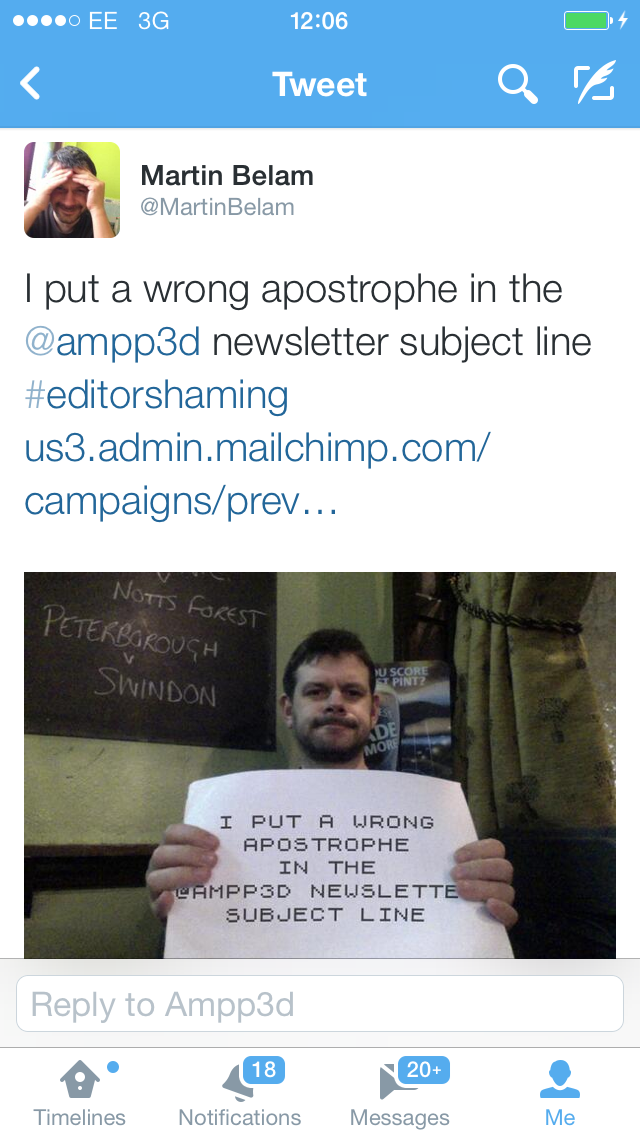
What’s next?
Ampp3d is coming towards the end of its probation period to prove it can attract an audience. We’ve had a couple of break-out hits with our Wayne Rooney real-time salary counter, and an explanation of how a “90% accurate” Alzheimer’s test can be wrong 92% of the time. I hope there will be the opportunity for more.
Thank you
A big thank you to all the people mentioned above, and also the Ampp3d team itself who have done so much to take the shell of the product idea and turn it into a living breathing journalism product: Federica Cocco, Anna Leach, Conrad Quilty-Harper, Jhinuk Sarkar, Tom Wills and Sophie Warnes.
